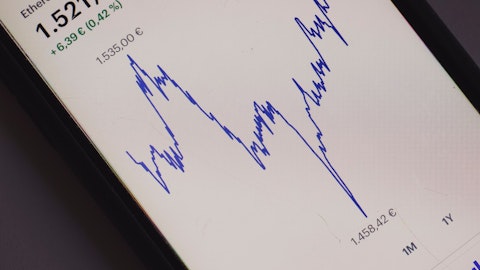Q – Rohith Chandra-Rajan: Rohith Chandra-Rajan. And just kind of follow on from that, actually. If your revenue aspirations end up being more capital intensive than you currently planned for, how would you deal with that? Would you not go for those revenues and maintain your RWA expectations? Or would you try and cut costs further to compensate? Or would — I guess the other option is to change your distribution. So when you’re thinking about those options, what would be the ordering there? So that was the first one. And then the second one was just, you’ve given us some very helpful information on how you’re re-segmenting the businesses. Curious to understand a bit more about how that changes the way that you actually run the business. So this essentially is a breaking out of subdivisions within existing businesses. So what synergies or improvements does that drive across the business? Is it just focus or is it something else?
A – C.S. Venkatakrishnan: Shall I try both?
A – Anna Cross: Yeah.
A – C.S. Venkatakrishnan: Okay. So I think when you look at the way we — Anna described the capital and the use of capital, she said there were three things. The first thing was to be a well-capitalized bank, and that is the 13% to 14%. The second thing was the shareholder returns, the £10 billion. And the third thing was after that, investments. If you look at the investments we’re making and have been making and we lay out in this plan, they are in businesses that are today returning in the high-teens or 20% and above. well above what most people would consider our cost of capital. So that’s basically the answer to your question, Rohith, that if we have that waterfall, we have the discipline that anything we are going to do is going to be above what is our accepted cost of capital.
And so, I don’t foresee ourselves breaking from that waterfall, right? We’re going to be guided by it. That’s the first part. On re-segmentation, and Anna, you should stick into both. But on re-segmentation, first of all, as I said, it’s guided by how we run our businesses and our clients. There are tremendous synergies, including synergies, which you might not easily anticipate. I spoke about the synergies between US cards and the UK cards business. Tesco is a 20 million credit card portfolio, 20 million is a lot of people to bring on to your systems. When we did GAAP, we did 10 million, right? So we clearly have an experience of a scale that, frankly, no other UK bank can match. You’ll also see synergies between private banking and wealth and our corporate bank, private banking and wealth and our investment bank in terms of both products and clients and, of course, private banking and wealth and our UK banking network.
We’ll talk about that and the corporate bank synergies to everybody else. So there are strong synergies, which we intend to exploit and continue to exploit as we go through this. And you’ll hear more about it in the afternoon, later today.
A – Angela Cross: I’ll just reiterate that the capital allocation priorities are very clear. On the second point, the way I think about it, we report how we manage, not the other way around. And we want to manage the business in a very client-focused way. And therefore, our reporting is changing in alignment with that. But we will still continue to generate the synergies that Venkat is talking about. We will still leverage common technologies and common services across our BX entity. So still very, very focused on keeping the firm connected with that consistency.
A – C.S. Venkatakrishnan: And when you think about that last point about common technologies and services, when you run a large bank today, as some of you who work in one now, there’s a lot of investment that you have to make. We spoke about some regulatory change. It’s models, it’s fraud systems, it’s all sorts of things, risk systems. And to be able to, in essence, spread it across many businesses is really important, right? So it’s a synergy in cost that people don’t often think about, but redeploying quantitative resources, redeploying databases and technology is a big part of it. Other questions? All right. So we reassemble at 10:45. So there is food and drinks at the back. We’ll come back to our regular presentations. The ladies, is somewhere there and the gents is somewhere outside. Thank you. So we’ll see you at 10:45, about 20 minutes.
End of Q&A: [Break]
C.S. Venkatakrishnan: Thank you. All right. So we’re now going to begin with the discussions about the individual businesses. We’ll begin first with the Investment Bank and then we’ll go to U.S. Cards and Barclays U.K. And then I will come back to spend two minutes on — not two minutes, a few minutes, on the U.K. Corporate Bank and Private Banking and Wealth. Later this year, you’re going to hear from the heads of those businesses in more detail. And then within the Investment Bank, Adeel Khan is going to talk about the Markets business. I will cover banking at a higher level. And later this year, you’ll hear from Kahil and Taylor in detail on banking. So let’s begin with the Investment Bank. For over two decades, investors have been asking questions about the size and the importance of Investment Bank at Barclays.
And you heard a little even today. Should we have it? Will it be competitive? Is it good for the U.K. to have an investment bank and more? Let me be very clear. I am proud of what we’ve achieved. We have built a leading business, a globally competitive investment bank. As I’ve said, it’s performed very well. It is at scale. It is a critical part of Barclays, and will continue to be an important part of Barclays. I’m equally clear that there is a lot more to do. Our investment bank has to be higher-returning, and relatively speaking, it has to become a smaller part of Barclays. As I’ve also said in answer to some of the questions, our Investment Bank is a focused business. We powerfully cover large sections of the global capital markets with deep client relationships.
And what we want to do is strengthen this position in our key areas of coverage. We aim to deepen our client relationships and to monetize the investments we have already made. And even as our investment bank grows in absolute income, we aim to hold our capital broadly flat to today’s levels. And so importantly, therefore, we expect a higher RoTE from our investment bank. And we’re going to be more efficient in our use of capital, as I’ve discussed earlier. But the simple way to think about it, is that we are looking for the Investment Bank to grow and to contribute more while consuming less, to contribute more while consuming less and we’re going to show you how. So what is the Investment Bank? We’ve changed that structure, as I mentioned earlier.
And so going forward, its two businesses: Global Markets and Investment Banking. Together in 2023, they contributed £11 billion of top line revenue to the bank. The UK Corporate Bank was part of what we called the CIB, and that is now reported separately and I’ll talk about it later. There is also an important business, the international corporate bank, which serves our largest corporate clients in the UK and elsewhere. It already works closely with our investment banking business but now will be managed, operated and reported as one unit. This combination of businesses will allow us to deepen our relationships with clients, both large cap and multinational corporates, which require access to the full spectrum of investment banking capabilities.
And so that is beyond DCM, ECM and advisory into corporate lending and transaction banking. The Global Markets business, which comprises fixed income and equities, remains the same. Important, of course, is how markets and banking cooperate and work together to deliver the entire suite of investment bank capabilities to our clients, and I’ll come back to that. So today, the investment bank has strong foundations. As I said, with the scale and breadth to succeed amongst our largest global peers, and we are focused on our core strengths, which is very important. It’s diversified and has a stable top line, which I will take you through, and we have focused top tier businesses and have demonstrated strong risk and capital discipline. The secret sauce in our investment bank is in our synergies.
I’ll repeat it. The secret sauce in our investment bank is in our synergies. We are big enough to offer multiple sophisticated products to our clients, but both nimble and culturally driven to work closely across banking and markets to customize delivery and to create tailored solutions. And this nimbleness and cultural drive are really important. In fact, we are renowned for the sophistication of our service, especially our fixed income and risk solutions for our clients. About 55% of our revenues come from the Americas, which is the largest financial market in the world, and which is why I believe we are the only known US domiciled investment bank that can consistently compete with the US banks and win. This audience more than anybody else should appreciate the importance of a strong research franchise.
And so I think you know us well here. We have many top research teams and we are maintaining momentum as a top five research house globally. We lead with data-driven content and help clients identify and adapt to changing thematic trends of the future, and these capabilities underpin our client relationships. And it’s an important ingredient in helping us grow our rankings both with our top 100 markets clients and with banking clients and you’ll hear Adeel about that in a minute. So let’s go to financial performance. Looking at our financial performance over the last three years, what you will see is that our income has been relatively stable at around £11 billion, and I’ll talk a little about that. But RoTE has reduced from 14% three years ago to 7% in 2023.
Both RWAs and costs have risen as we’ve invested deliberately in the business. But what we want to show you now is how we will improve our RWA productivity, capture cost efficiencies and generate income growth by monetizing the investments, which we have already made. We aim for the RoTE of the investment bank to be in line with the group’s greater than 12% target by 2026 through three key levers: income, RWA productivity and cost — income, RWA productivity and cost. So let me start with income. One reason why people have always questioned the value of the investment bank within Barclays is they think that it’s a volatile business. And up to a point, it is. There are parts of this business income that fluctuate with the markets and fluctuate with the economic environment.
What we have been doing though is to construct a business that has greater stability through two things: one is diversification and the other is what we call ballast, businesses with stable income. So if you look at the top-line, it has been in the £11 billion to £11.5 billion range since 2020 through changing, and some would argue, volatile market environment which include COVID, which include recent geopolitical instability. So let me take those two things first. First, you take diversification. We get diversification between the volatility-related elements of banking fees and market trading revenues or what we call intermediation, the top two lines. And in volatile markets, trading revenues go up, deal volumes tend to shrink. And in common times, the opposite happens.
So this means a combination of the two more stable than for banks which have only one deal making or only have trading, right? That’s the diversification between the relatively volatile elements. Then you come to the ballast, which is what you see circled at the bottom. And the first part of that is our financing income, the money which we make from lending to institutional clients against stocks, what people call prime, and against bonds, which we call fixed income financing. It’s a business in which we have invested heavily over the last number of years. It’s technologically complex and it’s very sophisticated. You have to manage the risks well. And our income has grown from around £1.8 billion in 2019 to £2.9 billion in 2023. Adeel will talk about this in a moment.





